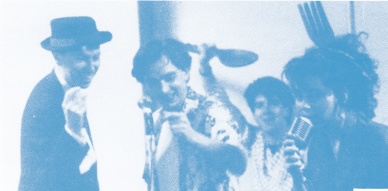
A couple of weeks ago, just before leaving on vacation, I took on the book description for Twee: The Gentle Revolution book. People agreed and disagreed with me and that was alright. It’s great to have a discussion. On that same post I promised going over the Salon Magazine article that was written by the author of the book were he talks a bit more in depth about it. So let me do this exercise and see if the description was just written to sell the book and there are many differences between what the publisher promotes and what the author really believes. Of course, we are still waiting for the book to be published as it will hit bookstores on June 3rd. But in the meantime…
But Twees were not Hipsters. Hipsters went out and did drugs and wore white belts. Twees, as I idealized, stayed in and wrote in their diaries (or on their blogs) and wore cardigans and listened to the Zombies, the Go-Betweens and Galaxie 500. They weren’t scruffy.
When I read this I got very optimistic. This sounded right to me. Maybe a bit of a stereotype, but in general lines indiepop people could fall into this description. But then he affirms that twees are hated more than hipsters and I’m not sure what does that mean. I feel that, for the normal people out, there they won’t be able to differentiate a hipster and a twee. They would be all the same. So then you might ask if a hipster hates a twee, or a twee hates a hipster. But that’s a very pointless question. Hipsters abound whereas the twee people are a minuscule group. Tiny. So no, I really not believe anyone hates the indiepop people. Nobody actually CARES about them really. And that’s totally fine. But I think the author has totally confused hipsters and twees. Even though he claims they are different groups then he is pretty sure to point out “Sure, they all moved to Brooklyn and ruined it“. As I said last time on the blog, there are a few indiepop people there, as there are a few too in Manhattan and Queens. So the question is, who really moved to Brooklyn? Well, it was mostly the hipsters, that’s pretty obvious. So he is mixing them up. Maybe he just hates hipsters.
And that’s more understandable. Hating hipsters is really easy. But that’s another conversation. Later on the article the author talks about a sameness that exists between songs and movies between many decades, even going further to the 1930s (!). This is something I’ve fought against a lot. That sort of idea that all indiepop is the same, that all of it comes from the same influences, wearing the same sort of uniform, etc etc. I found that this line of thought is very common to those that are alien to indiepop. In truth, for most people that are not knowledgeable about a specific music genre, when looking it from outside, it will usually sound and look the same. For a book like this though it’s pretty useful for the author to reduce it to sameness. It means less work, less research. It’s an easier way to prove his thesis. It’s wrong though because he is a music writer and he should know better. It’s pretty interesting that he mentions that “twees, as I saw them, were souls with an almost incapacitating awareness of darkness, death and cruelty, who made the personal choice to focus on essential goodness and sweetness“. Clearly he hasn’t got knee-deep in our beloved music. Even when listening to The Smiths you can tell that this belief of his is totally far off.
He also says that by 2012 there was some sort of explosion of twee entertainment. New Girl, Girls and Portlandia were the prime examples. Why are they twee? I don’t know. He mentions that Girls is a smart and feminist show. Does that make it twee? Sure indiepop people in it’s great majority are smart and feminist. But those are not exclusive traits of this scene. At this point I start to believe that for the author Twee just means quirky, witty and cute. It doesn’t mean anything else other than that. That the music is just an accessory, something that we all know that is not the case. It’s the music what we wear on our sleeves. It’s what defines us the mostly, our love for bands that go from yes, the Go-Betweens to more obscure bands like The Someloves. Indiepop is not defined for owning a kitty, for going to feminist rallies, or for watching these TV shows.
So he got it all wrong. What does this mean? In the situation that the book turns out to be popular (hopefully not), this may redefine the meaning of twee. It will be taken away from indiepop and become a more universal term. Who knows, twee.net will start getting a thousand hits then and possibly a proper twee scene will appear, all listening to She & Him and that sort of bands.
In a way that could be good, we’ve all preferred, for a long time, the term indiepop over twee. Perhaps after this we won’t use the word twee anymore. But it could happen the worst case scenario too. That where we’ll get pigeonholed into the sort of stereotype this guy is creating. It will be pretty uncomfortable if that happens.
The fact is, if there are people to blame for this whole situation, it’s us. Indiepop has been going for almost 30 years and only as of late some books are being written about it though mostly about specific topics like Sarah Records or Postcard Records. But a book encompassing the whole indiepop history, a book to understand twee and indiepop, properly reserached, well, we never produced it. It was just a matter of time then that someone outside the scene would see the opportunity and write something about it. Now we can only hope it doesn’t make a awful caricature of all of us. Let’s wait and see.
————————————————————-
I believe I know about the Subtonics from the future Leamington Spa list that was once listed on Twee.net. I was glad that during that same date I stumbled upon a copy of their 7″ on eBay and bought it blindly. It must have been 4 years ago. The cover art of the record was definitely not very indiepop-ish, but I gave it a try. If Uwe had listed it, then it was probably good.
As far as I know they only released one 7”. It was back in 1987 in Erdington, Birmingham, when the band put together these two songs, “Take it Easy Florence” on the A side and “Nothing to Lose” on the B side, and released them on vinyl.
The band was formed by:
Backing Vocals – Melanie Paige-Gibbins
Bass – Paul Kelly
Drums – Paul Comaskey
Fiddle – Aiden Forde
Saxophone – Nick Smith
Vocals, Guitar – John McElwee
And the record was produced by Subtonics. The sound engineer was Phil Savage and the recordings were made at Outlaw Sound Birmingham. The cover artwork was done by Annie Healy. The label that put the record out was Life of Man Records. Catalog was LOM 001 / 002. Perhaps a catalog number for each song? All songs were copyrighted to John McElwee.
The music is a bit folky, (I’m not a folk hater!), but it has a good indiepop element in it that makes both songs quite fun, especially the A side, with it’s classic chorus that sounds taken out from the mid 80s, reminding me of bands like The Rain or Home and Abroad. Of course, with the fiddle addition!
Included in the record there’s an insert written by a Richard V. Frank. He mentions that he was in Austin, Texas in 1985, and he was awaken by the music of Subtonics. Seems they were playing around the US. I wonder where else they played. On this same insert it says that in 1986 the band was deported from the US when it was discovered that they had been staying here as illegal aliens! Wow! Upon returning to Birmingham, Richard decided he loved so much the band that he paid for the record. What happened after? That part I don’t know. They split for sure.
The only other information I could track online was that the drummer, Paul Comaskey now actually lives in the US, in the North East and he still makes music as you can see in his bandcamp and soundcloud. In his bandcamp bio he doesn’t mention the Subtonics though. But it must be him as he comes from Erdington, Birmingham, right? He mentions that he has played in many bands like The Nervous Kind, The Music Lovers, The Sunshine Club and Richard Buckner.
What happened to the other band members? There is a John McElwee that is part of the New Yorker now. But is it the same one?
Does anyone remember this Birmingham band from back in the day? Did they release anything else? Did they record any more songs? Let’s solve the mystery!
::::::::::::::::::::::::::::::::::::::::::::::::::::::::::::::::::::::::::::::::::::::::::::::


6 Responses to “:: Subtonics”
Hi Roque, i think they did a radio session as well. i’m pretty sure that i have four other tracks by them on tape. will have a look!
I loved my time in The Subtonics and remember those songs so well . I left shortly after the release of the single and moved to NYC. The driving force behind The Subtonics was John McElwee .The Subtonics morphed into The Kings of Spain they released several albums to critical acclaim, John is still involved in the music scene in Birmingham hosting and performing at various songwriter events . I hope to see him later this year
I remember the Subtonics so well. An eclectic mix of indie/folk/popular/lyrical/jingly, jangly guitar/”lose yourself in it”/pure sophistication that was unique to the Subtonics and only the Subtonics in Birmingham at that time (circa 1980’s). They were “one of a kind” at the time and that is the only way that I can describe the brilliant writing capabilities of John McElwee and the lovely arrangements that followed with his fellow band-mates. The Subtonics always left me wanting to hear more and here I am in the 21st century still wanting to hear more….
Aiden hung himself !
Hanged himself !
Also sounds like the journalist is getting toooo far up his own bum. Obviously wants to write about something, if he was let out of hospital !